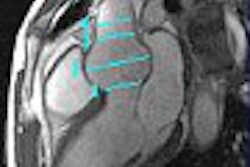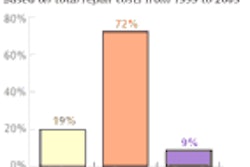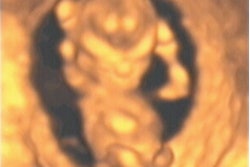ATLANTIC CITY, NJ - When unenhanced echocardiography studies are inadequate, adding contrast confers better patient care along with time and cost savings, according to Dr. Judy Mangion of Hartford Hospital in Hartford, CT.
"Contrast echo is certainly ready for prime time," Mangion said on Tuesday, during a presentation at the Leading Edge in Diagnostic Ultrasound conference.
Echocardiography labs today are under a great deal of pressure. The most commonly used cardiovascular testing modality, with over 18 million studies performed per year, echocardiography is valued for its ability to provide real-time, structural and functional information with rapid turnaround, Mangion said. It's also low-cost, portable, widely available, and associated with minimal patient discomfort.
However, there is a shortage of highly skilled echocardiographers. And the imaging study is often performed on obese, mechanically ventilated emergency room patients, intensive care unit patients, and preoperative and postoperative cases, who are supine and frequently can't move, Mangion noted.
"Over time, unfortunately, sonographers are at risk for developing musculoskeletal injuries," she said. "And it just seems that there's never enough time."
Despite the cost of ultrasound contrast agents, they can yield cost savings if they avoid additional testing, increase productivity, or avoid repetitive testing. In addition, agents can provide savings if they can answer the clinical question more efficiently, she said.
Prior research has found that up to 20% of resting transthoracic echo studies are non-diagnostic, and up to 30% of stress-echo studies are suboptimal, she said. Adding contrast would render many of those studies diagnostically adequate.
In addition to time savings for physicians, sonographers, and patients, contrast echocardiography also improves patient care by avoiding the possibility of an incomplete diagnosis or an incorrect diagnosis from a non-diagnostic echocardiogram.
Sonographers today are facing more demands, including the greater sophistication of testing and higher expectations. They are also being asked for higher quality and greater quantity of studies, Mangion said.
"The pressure is on, especially for stress echocardiography," she said.
Saving time and money
To make contrast echo both time and cost-efficient, echo labs should establish who is going to decide whether to use contrast, Mangion said.
"Sonographer-driven protocols are going to be much more time-effective," she said.
The timing of the decision to use contrast should also be identified, and it's best to make the decision as early as possible in order to mobilize the appropriate personnel for assistance in the contrast administration, Mangion said, adding that if the practice is legal in your state, it might also be a good idea to consider training sonographers to insert IVs.
An institutional policy on contrast administration should be set, including who can give contrast, the need for an order, consent requirements, and the process for getting the agent from the formulary.
Previous research has found contrast echocardiography to be cost-effective, Mangion noted. A 1998 pharmacoeconomic analysis discovered that contrast echocardiography yielded $119 in savings per patient, with an 86.7% diagnostic yield for contrast studies compared with a 49.3% diagnostic yield for non-contrast.
In another study, up to 29% of TTE studies were found to be inadequate or suboptimal; contrast reduced the number of those studies to less than 1%. That prospective study, which evaluated attending physician decision-making, found reductions in the number of additional tests and an average saving of $242 per patient from contrast echocardiography.
Getting paid
Contrast echo is reimbursable, although the amount differs from inpatient to outpatient settings, Mangion said. Outpatient studies with the Definity, Optison, and Imagent agents can use the contrast-specific HCPCS code (C9112). It's also important to note that Medicare pays 95% of the average wholesale price of the contrast media, Mangion said.
Inpatient studies would utilize CPT code A9700, which typically bills at $210 a vial, she said. Also, the CPT injection code for contrast is 90784, and an IV insertion can also be billed using the CPT code 36000.
By Erik L. RidleyAuntMinnie.com staff writer
May 12, 2004
Related Reading
Left ventricular hypertrophy accompanies obesity in young, healthy women, April 23, 2004
Emergency ultrasound training improves, but few ER docs meet AIUM guidelines, March 29, 2004
TDI acts as potential predictor in chronic congestive heart failure, March 11, 2004
Myocardial perfusion imaging shows promise in first-time heart failure, March 9, 2004
Resting MCE may prove superior to SPECT for identifying myocardial viability, March 7, 2004
Copyright © 2004 AuntMinnie.com




















